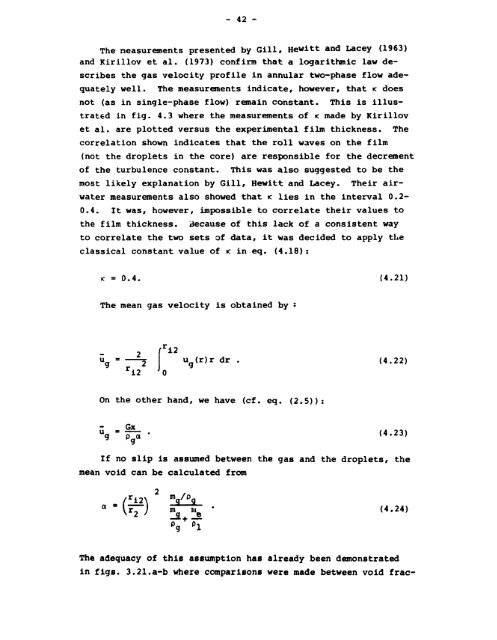An Experimental and Theoretical £ Investigation of Annular Steam ...
An Experimental and Theoretical £ Investigation of Annular Steam ...
An Experimental and Theoretical £ Investigation of Annular Steam ...
You also want an ePaper? Increase the reach of your titles
YUMPU automatically turns print PDFs into web optimized ePapers that Google loves.
- 42 -<br />
The measurements presented by Gill. Hewitt <strong>and</strong> Lacey (1963)<br />
<strong>and</strong> Kirillov et al. (1973) confirm that a logarithmic law describes<br />
the gas velocity pr<strong>of</strong>ile in annular two-phase flow adequately<br />
well. The measurements indicate, however, that < does<br />
not (as in single-phase flow) remain constant. This is illustrated<br />
in fig. 4.3 where the measurements <strong>of</strong> K made by Kirillov<br />
et al. are plotted versus the experimental film thickness. The<br />
correlation shown indicates that the roll waves on the film<br />
(not the droplets in the core) are responsible for the decrement<br />
<strong>of</strong> the turbulence constant. This was also suggested to be the<br />
most likely explanation by Gill, Hewitt <strong>and</strong> Lacey. Their airwater<br />
measurements also showed that < lies in the interval 0.2-<br />
0.4. It was, however, impossible to correlate their values to<br />
the film thickness. Because <strong>of</strong> this lack <strong>of</strong> a consistent way<br />
to correlate the two sets <strong>of</strong> data, it was decided to apply the<br />
classical constant value <strong>of</strong> < in eq. (4.18):<br />
< = 0.4. (4.21)<br />
The mean gas velocity is obtained by -<br />
2<br />
f r i2<br />
u_ 9 =<br />
i2 2<br />
0<br />
u g (r)r dr . (4.22)<br />
On the other h<strong>and</strong>, we have (cf. eq. (2.5)):<br />
»g = fjjj ' (4.23)<br />
If no slip is assumed between the gas <strong>and</strong> the droplets, the<br />
mean void can be calculated from<br />
a / r 2<br />
i2\<br />
m q /p q<br />
* \JT)
















